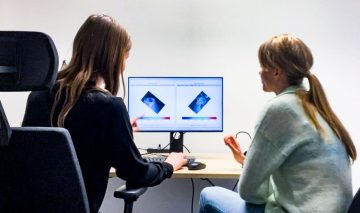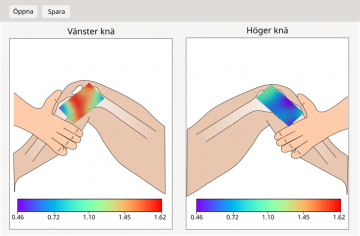
HEALTH AND TECHNOLOGY. A new method of diagnosing knee ligament injuries has been developed by researchers at Sahlgrenska Academy and Chalmers University of Technology. The method combines conventional diagnostics with image processing, and researchers hope it can provide both easier and more accurate diagnostics. It is currently being tested in a clinical environment to investigate its accuracy.
When a person seeks treatment for knee pain, the first thing clinicians investigate is a possible ligament injury. The examination involves subjecting the patient to several different physical tests to assess the stability, mobility, and hyper-mobility of the knee joint. Excessive mobility indicates damage to the ligament.
Improves objectivity
The new method will make the existing tests more objective. It involves filming the knee as the tests are performed and analyzing the video sequences with image processing to quantify the movements non-invasively. Movements filmed on the outside of the knee reflect the functioning of the ligaments inside the knee joint, because the movement of the joint directly controls the external movements.

Alice Nilsson and Linn Söderholm are both research assistants at Chalmers involved in developing the method.
“We hope that the method can be implemented in primary care and be a diagnostic aid for those unfamiliar with this type of examination of the knee joint so the method can serve as a communication aid when referring patients,” says Alice Nilsson.

“The method can also be used to follow up patients after surgery to ensure that the reconstruction of a damaged ligament is durable and to increase the chances of a safe return to the patient’s normal activity level,” says Linn Söderholm.
More equal care
The ongoing study is headed by Kristian Samuelsson, a professor of orthopedics at the University of Gothenburg and specialist in knee surgery and sports medicine. Other participants in the study include the Sports Rehab Physiotherapy Clinic and the orthopedics clinic at Mölndal Hospital, where the method is tested in a clinical environment and where data for evaluation is collected.

“If we succeed in creating an instrument that can reliably help healthcare providers make the right diagnosis, this will allow more patients to receive specialized care, will make care more equal, and more patients will receive the correct assessment and treatment early,” says Eric Hamrin Senorski, an associate professor of physiotherapy and participating researcher in the study. He is also involved in developing the method. “If the method also succeeds in quantifying with high precision the kinematics that occur during musculoskeletal examination, it will represent a new method for evaluating patients’ treatment, both surgically and after rehabilitation.”

Ligaments in other joints
Pain in other joints, such as the wrist and ankle, can also be assessed to determine the function of the ligaments. Anders Björkman, a professor of hand surgery, and Nenad Zeba, a chief physician in hand surgery, see the potential of the new method for diagnosing wrist injuries.

“The wrist has a very large number of ligaments that stabilize the joint during movement. These ligaments are often injured, such as in falls,” says Björkman.
“Assessing wrist ligament function through a clinical examination is very difficult and almost always requires specialist skills in hand surgery. A method that can easily and reproducibly assess ligament function in the wrist would improve the diagnosis and treatment of a large group of patients,” says Nenad Zeba.
Bridging health and technology
The project is one of several collaborations between Chalmers and Sahlgrenska Academy. Martin Fagerström is the responsible researcher at Chalmers. He was involved in development of the method and is participating in the ongoing study. In his role as deputy head of Health Engineering and coordinator of Chalmers Sports & Technology, he is involved in several collaborative projects.

“Collaborations like these are extremely motivating! It is also very compelling to see what ideas and new technologies can be developed when challenges in healthcare are addressed unconditionally in a multidisciplinary grouping like this,” says Fagerström.
The current study aims to collect sufficient data to allow evaluation of how accurately the method can identify injured knees. The study will also evaluate ease of use in consultation with future users to identify what is needed for the method to be used clinically.











